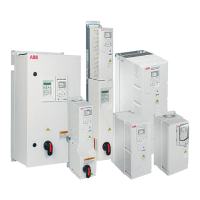Connecting the power cables
■ Connection diagram
L1 L2 L3
T1/U T2/V T3/W
UDC+
R+R-
L1 L2 L3(PE) (PE)PE
PE
U1
V1
W1
3 ~ M
1
2a
2b
3
5
6a
4
3
7
6b
For alternatives, see Selecting the main supply disconnecting device (page 87)
1
With a conduit: Use a separate grounding PE cable (2a) or a PE conductor (2b) inside the
conduit if the conductivity of the conduit does not meet the requirements for the PE conductor
(see General guidelines (page 96).
2
With a shielded cable: Use a separate grounding PE cable (2a) or a cable with a separate
PE conductor (2b) if the conductivity of the shield does not meet the requirements for the
PE conductor (see General guidelines (page 96)).
Note: If the cross-section of the Cu PE conductor is less than 8 AWG, install a second Cu
PE conductor of the same cross-sectional area as the original PE conductor. Alternatively,
you can use a Cu PE conductor with at least 10 mm
2
cross-section. See page 24.
With the conduit: Make sure of a proper grounding of the conduit at the cable entry. Ground
the other end of the conduit and PE conductor (if used) at the distribution board.
3
With a shielded cable: Do a 360-degree grounding if shielded cable is used. Ground the
other end of the input cable shield and PE conductor (if used) at the distribution board.
With the conduit: Make sure of a proper grounding of the conduit at the cable entry.4
With a shielded cable: Do a 360-degree grounding of the shield.
172 Electrical installation – North America

